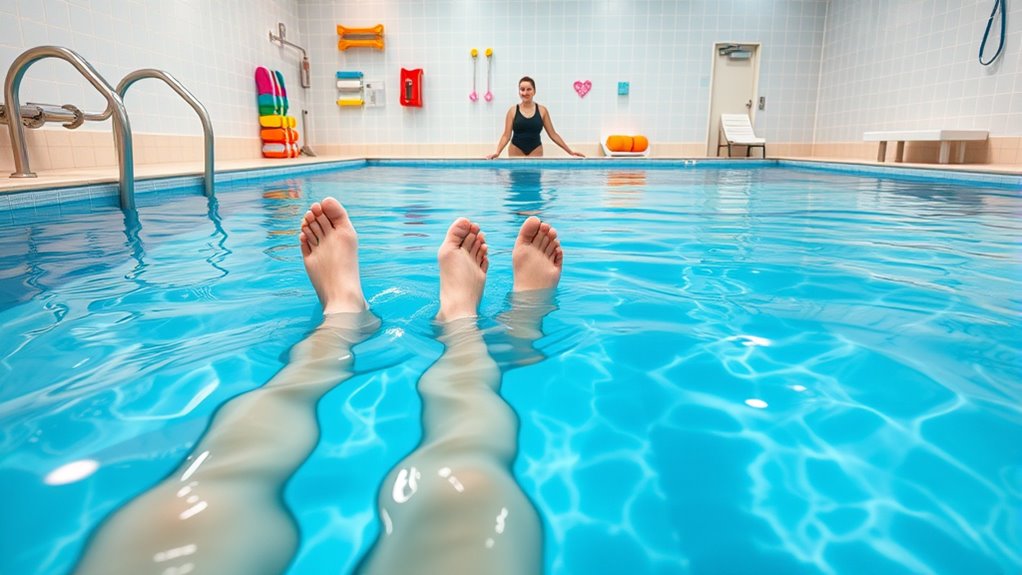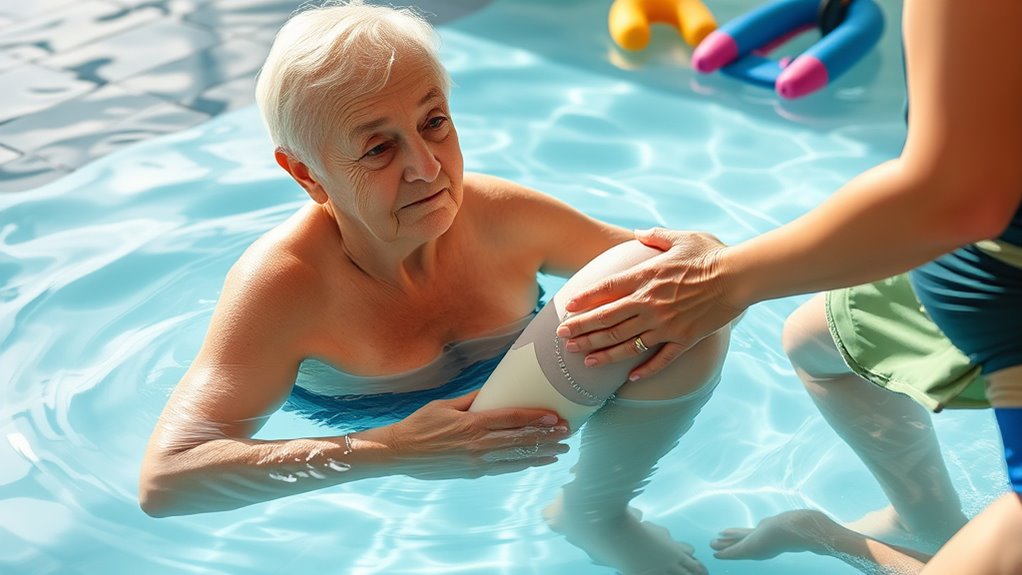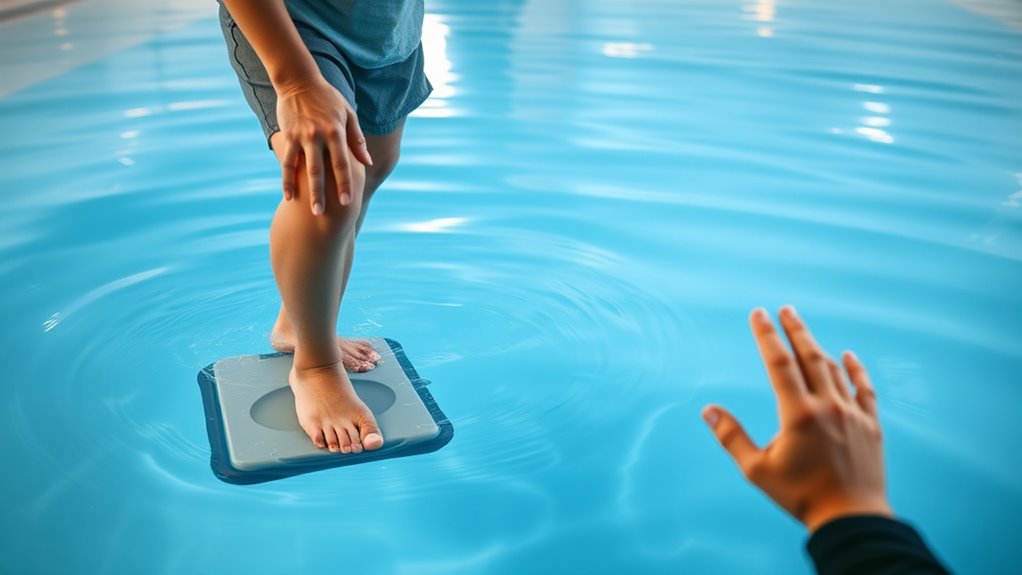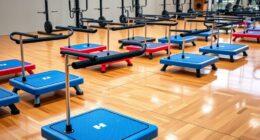Aquatic therapy for arthritic knees involves gentle exercises in warm water that reduce joint stress, alleviate pain, and boost flexibility. You’ll gradually perform walking, resistance, and balance activities tailored to your needs, guided by a therapist. The water’s buoyancy and resistance support safe movement and muscle strengthening. Expect improvements in mobility over time, but safety and communication are key. Keep exploring to discover how to get the most from this helpful treatment.
Key Takeaways
- Aquatic therapy reduces joint stress, alleviates pain, and improves flexibility for arthritic knees through water-based exercises.
- Sessions are tailored to individual needs, focusing on gentle movements, resistance training, and balance exercises.
- Warm water relaxes muscles and decreases stiffness, while water buoyancy supports body weight, minimizing knee pressure.
- Proper technique and communication with the therapist are essential to maximize safety and effectiveness during exercises.
- Equipment like water weights and resistance bands enhance muscle strengthening, with safety precautions observed throughout therapy.
Understanding How Aquatic Therapy Works for Knee Arthritis

Because water reduces the impact on your joints, aquatic therapy provides a safe environment for knee arthritis sufferers to move and strengthen without pain or strain. The buoyancy of water supports your body, decreasing pressure on your knees and allowing you to perform exercises that might be painful on land. The water’s resistance helps build muscle strength and improve joint stability with less risk of injury. Warm water also relaxes muscles, increases circulation, and reduces stiffness, making movement easier. During sessions, you’ll do controlled movements tailored to your needs, focusing on flexibility and strength. This environment encourages consistent activity without overloading your joints, which is essential for managing arthritis symptoms and maintaining mobility. Additionally, temperature regulation in the water can be optimized through temperature adjustments to further enhance relaxation and comfort during therapy sessions. Incorporating hydrotherapy techniques can also amplify the therapeutic benefits, promoting faster recovery and pain relief, especially when combined with proper exercise protocols designed for arthritis management. Moreover, selecting the right pool environment can significantly influence the effectiveness of therapy and patient comfort.
Preparing for Your First Aquatic Therapy Session

Before your first aquatic therapy session, make sure to wear comfortable, appropriate attire that allows easy movement. Arrive early so you have time to relax and discuss your medical history with the therapist. Sharing this information helps guarantee your treatment is safe and tailored to your needs. Additionally, understanding aura concepts can provide insight into emotional and physical states, which may enhance your overall therapy experience. Being aware of self watering plant pots can also inspire patience and consistency in your approach to healing. Developing awareness of Relationship dynamics can improve communication skills and foster a more supportive environment during your recovery. Incorporating data-driven strategies can help you track your progress and stay motivated throughout your treatment. If you are considering the legal aspects of your situation, knowing the divorce process and requirements can help you prepare effectively.
Wear Appropriate Attire
Are you wondering what to wear for your first aquatic therapy session? Comfort and mobility are key. Opt for a well-fitting swimsuit that stays in place and allows movement. Avoid heavy fabrics or clothing that absorbs water, as they can weigh you down. Consider bringing a towel and flip-flops for after your session. Here’s a quick guide to attire:
| Feature | Why It Matters | Recommendations |
|---|---|---|
| Fit | Prevents shifting during exercises | Snug but not tight |
| Material | Quick-drying and lightweight | Lycra or nylon |
| Coverage | Protects sensitive skin | Full or tankini styles |
| Accessories | Keeps hair and skin dry | Swim cap, goggles |
Arrive Early Prepared
Arriving early for your first aquatic therapy session gives you time to settle in and prepare comfortably. When you arrive ahead of your scheduled time, you can check in smoothly and get familiar with the facility. Use this extra time to change into your attire, such as a swimsuit or appropriate workout clothes, and store your belongings securely. Feeling prepared helps reduce anxiety and allows you to focus on the therapy ahead. If you have questions or need assistance, arriving early gives you the chance to speak with the staff without feeling rushed. Being punctual and prepared ensures you start your session relaxed and ready to make the most of your aquatic therapy experience.
Share Medical History
Have you prepared your medical history for your first aquatic therapy session? Sharing accurate and detailed information helps your therapist customize your treatment. Be ready to discuss your arthritis diagnosis, previous injuries, surgeries, and current medications. Mention any other health conditions, such as heart problems or infections, that might affect your safety in the water. If you experience pain, stiffness, or swelling, note when and how often these occur. Providing your medical history also includes sharing past therapies or treatments you’ve tried. Being open and thorough ensures your therapist understands your limitations and goals. This information helps prevent complications and maximizes the benefits of your aquatic therapy. Don’t hesitate to ask questions or clarify anything during your session.
What Equipment and Facilities Are Used

To effectively perform aquatic therapy for arthritic knees, specialized equipment and facilities are essential. You’ll typically use a heated pool designed for therapeutic purposes, with water temperatures around 88-92°F to reduce joint stiffness and pain. The pool should have easy access features like ramps, handrails, and non-slip surfaces for safety. Equipment such as water weights, resistance bands, and floating devices help you perform targeted exercises while minimizing joint stress. Some facilities also include underwater treadmills or stationary bikes, allowing for a broader range of motion and strength training. Proper lighting and a quiet environment promote focus and comfort during your session. These facilities are designed to assure safety, accessibility, and effectiveness, helping you get the most out of your aquatic therapy. Additionally, AI safety measures are increasingly integrated into healthcare technology to ensure secure and effective treatment environments. Incorporating advanced monitoring systems can further optimize your therapy sessions by tracking progress and adjusting exercises in real-time. Recognizing the importance of specialized equipment, many centers constantly update their tools to align with the latest therapeutic techniques. Moreover, ensuring proper water quality and sanitation is vital for maintaining a safe and hygienic environment during therapy sessions.
Typical Activities and Exercises in the Pool

In aquatic therapy for arthritic knees, a variety of activities and exercises are designed to improve strength, flexibility, and joint function while minimizing pain. You might do gentle walking or marching in the pool to boost circulation. Water resistance helps strengthen muscles without stressing your joints. Balance exercises, like standing on one leg or shifting weight, improve stability. Flexibility routines include leg stretches and gentle knee bends. Incorporating joint-friendly movement can enhance overall benefits and support long-term joint health. Here’s a quick overview:
| Activity | Purpose | Example |
|---|---|---|
| Walking in water | Improve circulation & strength | Marching or casual walking |
| Resistance exercises | Build muscle without strain | Using water weights or noodles |
| Balance drills | Enhance stability | Standing on one leg in water |
| Stretching | Increase flexibility | Gentle knee and leg stretches |
How Your Therapist Customizes the Program

Your therapist tailors the aquatic therapy program to match your specific needs, goals, and limitations. They start by evaluating your knee condition, mobility level, and pain points. Based on this, they select exercises that maximize benefits while minimizing discomfort. Your therapist also considers your activity preferences and daily routines, ensuring the program fits your lifestyle. They might modify exercises, adjusting resistance, water depth, or movement types to suit your progress. Throughout your sessions, they monitor your response and make real-time adjustments to ensure safety and effectiveness. This personalized approach helps you build strength, improve flexibility, and reduce pain at a comfortable pace. Additionally, understanding emotional support can enhance your motivation and adherence to the therapy plan. Recognizing the importance of physical and emotional well-being can further motivate you to stay committed. A thorough assessment of your medical history allows your therapist to identify potential risks and tailor interventions accordingly. By customizing your program, your therapist ensures you get the most out of each session, making your recovery more efficient and tailored to your unique needs.
The Role of Water Temperature and Depth

The temperature of the water can considerably influence your comfort and the therapy’s effectiveness. Warmer water helps relax muscles and reduce joint pain, while cooler water can decrease inflammation. Essential oils for pain relief can be incorporated into aquatic therapy to further enhance pain reduction and relaxation effects. The depth of the water also matters, as it affects how much weight your knees support and the level of resistance you encounter during exercises. Additionally, sound recording techniques can be employed to monitor and analyze patient progress during aquatic therapy sessions. Understanding the benefits of water temperature can help tailor therapy to individual needs. Incorporating fatherhood principles such as patience and encouragement can also enhance the emotional well-being of patients during therapy.
Impact of Water Temperature
Water temperature plays a crucial role in the effectiveness of aquatic therapy for arthritic knees. Cooler water can reduce inflammation and numb pain, helping you move more comfortably during sessions. On the other hand, warmer water relaxes muscles, improves circulation, and eases stiffness, making exercises easier and less painful. The right temperature depends on your specific needs and therapy goals. If you experience significant pain or inflammation, your therapist may suggest cooler water to minimize discomfort. Conversely, if stiffness limits your movement, warmer water can help loosen your joints and muscles. Maintaining the appropriate water temperature ensures you get the most benefit from your therapy while minimizing discomfort. Always communicate with your therapist about how the water feels so adjustments can be made.
Effects of Water Depth
Adjusting water depth in aquatic therapy influences how your body responds to exercises and the overall comfort you experience. When you change the depth, it affects the level of support, resistance, and buoyancy you feel. Shallow water allows for more targeted movements and easier balance, while deeper water reduces joint stress and increases resistance. It also impacts your confidence and safety during exercises.
- Shallow water provides better stability and control for delicate movements
- Deeper water minimizes joint impact and reduces pain
- Water resistance increases with depth, making exercises more challenging
- Buoyancy at different depths helps support your knees and improve mobility
Expected Benefits and Possible Limitations

Aquatic therapy offers several notable benefits for individuals with arthritic knees, primarily by reducing joint stress and allowing for more comfortable movement. This environment can help decrease pain, improve flexibility, and strengthen supporting muscles without putting excessive strain on your joints. You’ll likely notice increased mobility and decreased stiffness over time. However, there are some limitations to contemplate. Not everyone responds equally, and progress can vary based on severity and individual health. Access to facilities and trained therapists might also be a hurdle for some. Additionally, water-based exercises may not directly translate to land activities, and your condition could limit certain movements. While aquatic therapy provides significant relief for many, understanding these potential limitations helps you set realistic expectations and make informed decisions about your treatment plan.
Safety Precautions During Aquatic Therapy

Ensuring safety during aquatic therapy is essential to maximize benefits and prevent injuries. You should always follow your therapist’s instructions closely and communicate any discomfort immediately. Be cautious when entering and exiting the pool to avoid slips or falls. Make sure the water temperature is appropriate, typically between 83-88°F, to prevent overheating or chills. Use any recommended safety gear, such as waterproof shoes or floats, to enhance stability. Always inform your therapist of any medical conditions or medications that might affect your safety in the water.
Prioritize safety in aquatic therapy by following instructions, using safety gear, and communicating medical concerns.
- Wear proper footwear to prevent slipping
- Stay hydrated and avoid overexertion
- Avoid sudden movements or jumping
- Follow all pool safety rules and guidelines
Tips for Maximizing Your Progress

To get the most out of your aquatic therapy, stick to a consistent exercise schedule and follow your therapist’s guidance closely. Focus on proper technique to prevent injury and make certain you’re targeting the right muscles. Always communicate any discomfort clearly so adjustments can be made to keep your progress safe and steady.
Consistent Exercise Routine
Maintaining a consistent exercise routine is key to seeing steady progress in managing arthritic knee pain. When you stick to your schedule, your joints become more flexible, and pain decreases over time. Consistency helps build strength and endurance, making daily activities easier. To keep yourself motivated, try to set realistic goals and track your progress. Remember, small, regular steps lead to long-term benefits.
- Schedule workouts at the same time each day
- Vary your exercises to prevent boredom
- Listen to your body and rest when needed
- Celebrate your improvements, no matter how small
Proper Technique Emphasis
Focusing on proper technique is essential for maximizing your progress in aquatic therapy for arthritic knees. Always follow your therapist’s instructions closely to guarantee you’re performing exercises correctly. Pay attention to your body’s signals; avoid pushing through pain, and modify movements if needed. Keep your movements controlled and deliberate, focusing on smooth, steady motions rather than speed. Maintain good posture and alignment to prevent strain and optimize benefits. Use breathing techniques to stay relaxed and engaged during exercises. Proper technique not only helps prevent injury but also targets the right muscles, improving joint support and function. Consistent focus on form accelerates healing and ensures you get the most out of each session. Remember, quality always trumps quantity.
Communicate Discomfort Clearly
Clear communication about discomfort during aquatic therapy helps guarantee you get the most benefit while staying safe. If something doesn’t feel right, speak up immediately. This ensures your therapist can adjust the exercises or intensity to prevent injury and reduce pain. Be specific about how you feel, whether it’s sharp pain, tightness, or fatigue. Don’t assume the therapist knows your limits; your feedback guides your progress. Remember, it’s okay to pause or ask for modifications. Effective communication also helps build trust and creates a supportive environment.
- Use clear, descriptive language to explain your sensations
- Alert your therapist if pain worsens or persists
- Ask questions about exercises if unsure
- Share any changes in symptoms during sessions
When to Expect Results and Next Steps

You can typically start noticing improvements in your knee mobility and pain levels within a few weeks of beginning aquatic therapy, but the timeline varies based on individual factors. Consistency is key, so attending sessions regularly helps speed up progress. In the first month, you may see reduced swelling and increased ease in movement. As therapy continues, expect to build strength and stability around your knee. Your therapist will monitor your progress and adjust the program accordingly. Next steps depend on your goals and response to treatment; they may include more advanced exercises or shifting to land-based activities. Remember, patience is essential—everyone heals at their own pace. Stay committed, communicate openly with your therapist, and celebrate small victories along the way.
Frequently Asked Questions
Can Aquatic Therapy Be Combined With Other Treatments for Knee Arthritis?
Yes, you can combine aquatic therapy with other treatments for knee arthritis. It often works well alongside medications, physical therapy, and lifestyle changes like weight management. Your healthcare provider might recommend a tailored plan that includes multiple approaches to reduce pain and improve mobility. By integrating aquatic therapy with these options, you can enhance your overall results and enjoy better knee function more quickly.
How Long Does Each Aquatic Therapy Session Typically Last?
Each aquatic therapy session usually lasts about 30 to 45 minutes, depending on your specific treatment plan. You’ll start with warm-up exercises, followed by targeted movements to improve strength and flexibility. You might also do some relaxation or stretching at the end. The therapist will monitor your progress and adjust the duration if needed. Overall, sessions are designed to be comfortable and effective, helping you manage knee arthritis symptoms.
Are There Any Age Restrictions for Aquatic Therapy Participation?
You might wonder if age limits your access to aquatic therapy. Remarkably, many clinics welcome participants of all ages, from children to seniors. Over 30% of older adults benefit from aquatic therapy to improve mobility and reduce pain. If you’re over 65, you’ll likely find programs tailored for your needs. Age isn’t usually a barrier; it’s about your health, comfort, and whether your doctor approves of aquatic exercises.
What Should I Do if I Experience Pain During Therapy?
If you experience pain during therapy, don’t ignore it. You should immediately inform your therapist about your discomfort. They can adjust the exercises or intensity to better suit your needs. Remember, some initial discomfort is normal, but persistent or sharp pain isn’t. Trust your body and communicate openly so your therapy remains safe and effective. Your therapist is there to help you progress comfortably and avoid further injury.
Is Insurance Coverage Available for Aquatic Therapy Sessions?
You might wonder if your insurance covers aquatic therapy sessions. Coverage varies depending on your plan and provider. Some insurance plans include aquatic therapy as part of physical or occupational therapy benefits, especially if your doctor recommends it for your arthritis. It’s best to check with your insurance company directly or review your policy details to understand what’s covered, any restrictions, and whether you’ll need pre-authorization.
Conclusion
So, after all that splashing and stretching, you might find yourself surprised—your knees feeling better, yet still longing for the good old days of pain-free walking. Irony strikes: the very therapy designed to ease your joint woes could turn into your favorite way to relax. Keep at it, stay safe, and remember, sometimes the best cure is just a little water under the bridge—or in this case, over your knees.









